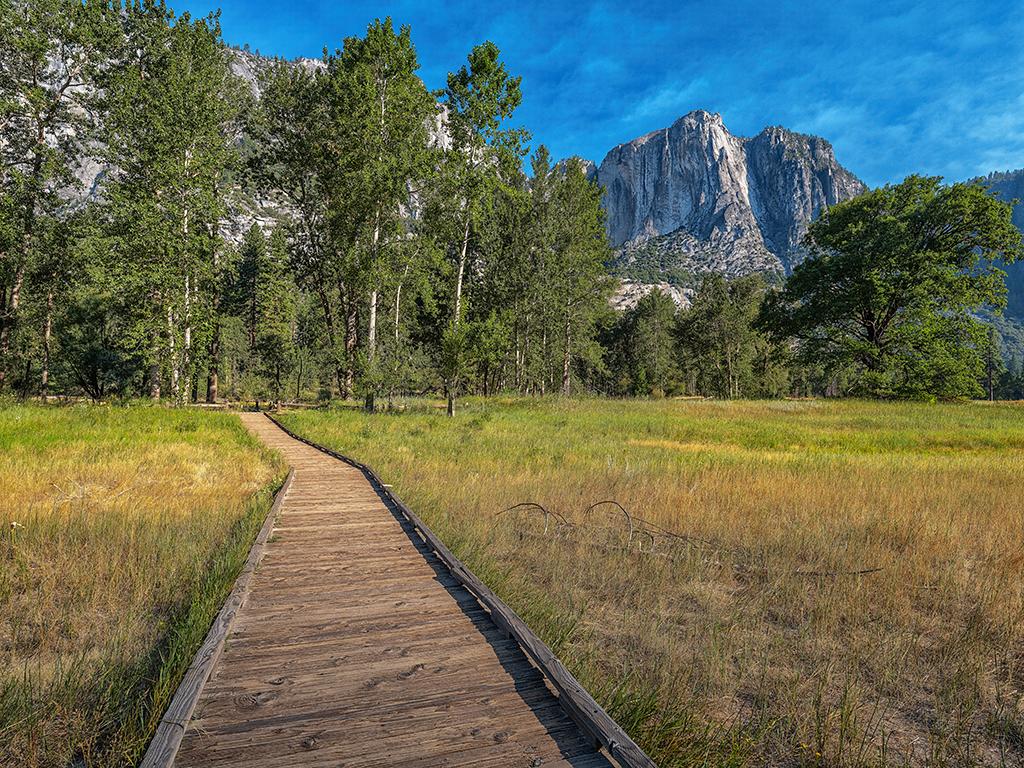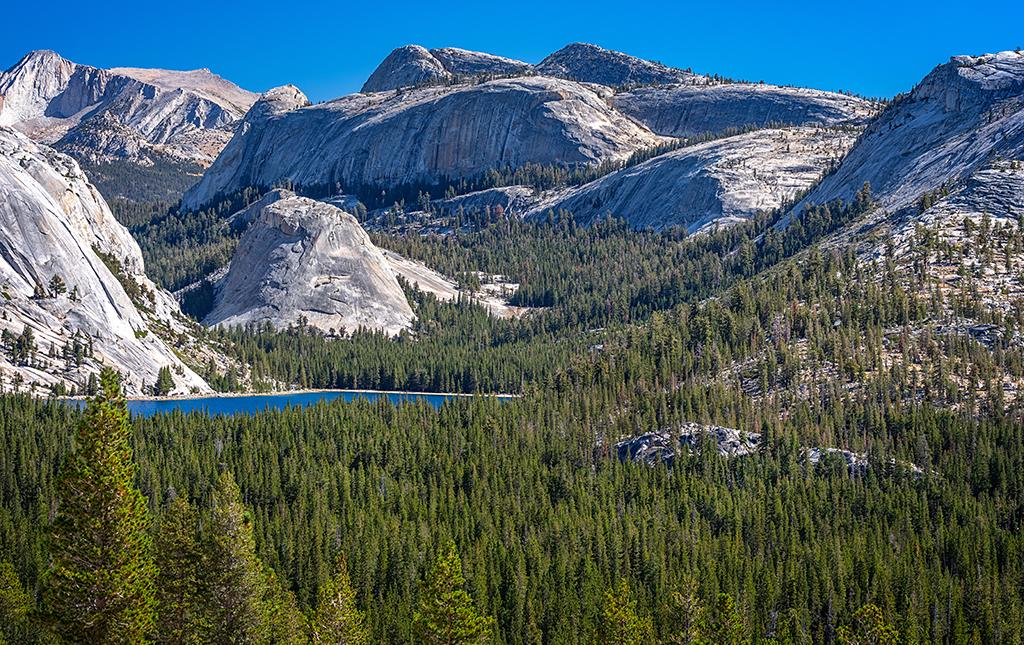Stick your head into Yosemite Valley and you'll quickly come to appreciate why they say that 95 percent of the park's visitors can be found in this spectacularly scenic valley. And while it's good they've come to explore the valley, they'll head home greatly shortchanged if they don't explore the rest of the park.

A late-summer sunset over the Yosemite Valley from Tunnel View, Yosemite National Park / Rebecca Latson
There's no doubt that the Yosemite Valley is the focal point of the park. With its feathery waterfalls, soaring granite walls, and tranquil Merced River coursing down the middle of the 7-mile-long (11.26-km) valley, the setting is unparalleled. But it's not the only vista worth setting your eyes on during a visit to Yosemite. With that understood, here are Traveler's recommendations for to-dos that should be on your itinerary when you visit Yosemite.
* One year out from when you want to visit Yosemite, visit Aramark’s Yosemite lodging website or call (888-413-8869 ) to line up a place/places to stay. Yosemite's popularity can make a mess of your vacation if you don't lock up rooms far ahead of your trip.
* Yosemite requires ticketed entry reservations during peak visitation times from April 13 – October 7 (2024), so figure out the day(s) you’ll be visiting the park, then head on over to recreation.gov and pay $2 for a non-refundable ticket. Traveler’s Note: You can enter the park without a ticket by visiting before 5 a.m. or after 4 p.m. If you already have a reservation for in-park camping, lodging, or vacation rental, or if you have a wilderness permit or are part of a tour group, you will not need to purchase the extra entry reservation.

I spy with my little eye, the red shirt of a climber on El Cap, Yosemite National Park / Rebecca Latson
* Do visit the Yosemite Valley. It's both immense and intimate at the same time. Park your car and walk the trails below Yosemite Falls, check out the activity at the historic Camp 4 climbers' camp, stand in El Capitan Meadow and "glass" the sandstone giant to see if you can spy any climbers working their way up this icon.
* Check out the Ansel Adams Gallery. Located in the heart of the valley not far from Upper and Lower Yosemite Fall, the historic gallery has been under the same family since 1902. Knowing Ansel Adams' work, walking into the gallery can feel akin to entering a photographic cathedral. Once inside you'll find not only copies of his works to admire and purchase, but a well-stocked book section and scores of prints from a wide range of artists as well as some camera equipment (like tripods) in case you forgot something at home.
* Make a note to visit, on the opposite side of the valley, sometime before you leave the Yosemite Conservation Heritage Center (open from Wednesday through Sunday from 10 a.m. to 4 p.m. from May through September.) This small stone structure was the valley's very first visitor center. Opened by the Sierra Club in 1904, the building today offers evening programs and a well-stocked library on environmental topics that you can browse.

Looking down into the Ahwahnee Hotel grand lobby, Yosemite National Park / Rebecca Latson
* Stroll through The Ahwahnee, which, like the Yosemite Conservation Heritage Center, is a National Historic Landmark. You don't have to stay there, but this grandiose, six-story structure is a main figure in the architectural history of the national parks. Designed by Gilbert Stanley Underwood, who also designed lodges in Grand Canyon, Bryce Canyon, and Grand Teton national parks, this imposing castle oozes “blue blood” elite class, having housed royalty, presidents, and many from the Hollywood A-List. But that doesn't mean you can't stroll the halls, enjoy the artworks lining them, set in the Great Lounge that is book-ended by two spacious stone fireplaces, grab a drink in the lounge, or enjoy the Sunday buffet.
* Sample some of the valley's hikes. You'll regret not hiking up, at least to the top of Vernal Fall, the Mist Trail, what with its handcrafted trail stonework, the billowing mists that both cool you in summer and wrap you in rainbows, and the route it provides to Half Dome. Push on beyond Vernal Fall and you can stand atop Nevada Fall with its spectacular view of the valley down below. Venture up to Mirror Lake, which in spring captures reflections of both Half Dome and Mount Watkins. It's an easy 2-mile (3.2 km) roundtrip. More strenuous paths lead to Glacier Point and the top of Yosemite Fall, but will take a day.

I spy with my little eye, the tiny figures of people climbing up Half Dome, Yosemite National Park / Rebecca Latson
*If you feel up to it and are in good enough condition, hike up Half Dome. You’ll need a day hike permit for this, and only 300 hikers are allowed each day to hike on the trail. Permits for day hikers are distributed by lottery via recreation.gov at a cost of $10 (non-refundable), with a $10 recreation fee per person to the permit winner. There is one preseason lottery having an application period in March and daily lotteries during the hiking season. Backpackers—including those who plan to spend the night in Little Yosemite Valley—should apply for Half Dome permits with their wilderness permit.
* Spend some time in the Yosemite Museum and Indian Village to learn both the history of whites in the valley and that of the Native American tribes, the Miwoks and Paiutes, that occupied the valley before being forced out. Time your visit right and you can watch demonstrations of basket-weaving and beadwork. There's even a reconstructed Indian Village of Ahwahnee behind the museum.

Wandering the boardwalk over a Yosemite Valley meadow, Yosemite National Park / Rebecca Latson
* Get up early, just before sunrise if possible, and walk one of the Yosemite Valley's meadows to enjoy the quiet and marvel in the Sierra sunrise.
Don't expend all your energy in the Yosemite Valley, for there's much to see beyond its confines.

Grizzly Giant in Mariposa Grove, Yosemite National Park / Rebecca Latson
* Head down to Wawona for a walk through the Mariposa Grove of giant sequoias. These big trees -- there are hundred in this grove -- are just incredible to walk around. You can drive your own car, take a free shuttle, or hike the trail up to this grove. Two other groves of sequoias can be found just outside the northwestern corner of Yosemite Valley. The Tuolumne and Merced Groves are found near Crane Flat, but you'll need to hike 1-2 miles (1.6 - 3.2 km) one-way to reach them.
* While you're in the Wawona area, check out the Yosemite History Center. The collection of historic buildings here (pulled from various locations elsewhere in the park), include a Wells Fargo office, blacksmith shop, ranger cabin, and an early jail. Enter the "Artist Cabin" and you'll find a nice history on the artists who were drawn to Yosemite and the impact their works had on the growing popularity of Yosemite. There's also a covered bridge here, and you can take a stagecoach ride.

A view of the Yosemite Valley from Glacier Point, Yosemite National Park / Rebecca Latson
* On the way back from Wawona, turn right on the appropriately named Glacier Point Road and head 16 miles (25.7 km) down to Glacier Point. While many aspire to stand atop Half Dome so they can gaze down into the Yosemite Valley, the view from Glacier Point, 3,200 feet (975 m) above Yosemite Valley, is even more stupendous if for no other reason than the fact that you can also take in Half Dome from this perch. If you're staying in the valley, you can take a bus tour to Glacier Point, and hike down to the valley.

A view of Tenaya Lake and the High Sierras along Tioga Road, Yosemite National Park / Rebecca Latson
* Meander the Tioga Road. Running nearly 60 miles (97 km) from Crane Flat to the park's Tioga Pass Entrance Station above the town of Lee Vining, this byway proves no car's windshield is broad enough to capture all the splendor of the high country that lines this route. Stop to spend time scrambling across the granite domes that are studded with conifers, plan a picnic for the shores of Tenaya Lake, walk the shores of the Tuolumne River, hike down to Cathedral Lake, or plan an overnighter along the John Muir Trail.
*Stop at as many view areas and overlooks as you can. They built these because of the views, geology, or other interesting facets about this national park.

Olmsted Point is a great place to stop and take in the granite Sierras as well as distant views of the landscape, including Half Dome, Yosemite National Park / Rebecca Latson
* Instead of making a right turn onto the Tioga Pass Road, stay on Big Oak Flat Road, which becomes Evergreen Road. At Mather, keep right onto Hetch Hetchy Road and drive all the way out to the Hetch Hetchy Reservoir and O’Shaughnessy Dam, which provides water to some 2.7 million thirsty people in the San Francisco Bay Area. There’s a range of trails from backcountry to day hikes. Be aware: depending upon your time of visit, you might encounter haze in the air from area wildfires and the nearby waterfalls may be dried up. It gets hot out there, so take plenty of water and salty snacks with you.

O'Shaughnessy Dam and Hetch Hetchy Reservoir, Yosemite National Park / Rebecca Latson
* Consider winning a lottery spot in one of the High Sierra Camps that dot Yosemite's high country. These backcountry camps, reached either on foot or astride a saddle, offer comfortable cots with warm blankets in tent cabins come nightfall, and there's a central dining tent where chefs serve up wonderful meals. With no need to carry housing, bedding, and food on your back, these camps enable you to take in some great, easy hiking through the High Sierra.
* If you enter or exit the park through the Tioga Pass Entrance Station, pull over at the small parking area on the north side of the road and check out the old entrance station. It was built in 1931, and the log-and-rock construction is gorgeous. There's a nice 2-mile (3.2-km) roundtrip hike to Gaylor Lake here that is definitely worth the effort.
If that's not enough to keep you busy, consider an extended backcountry trek.





